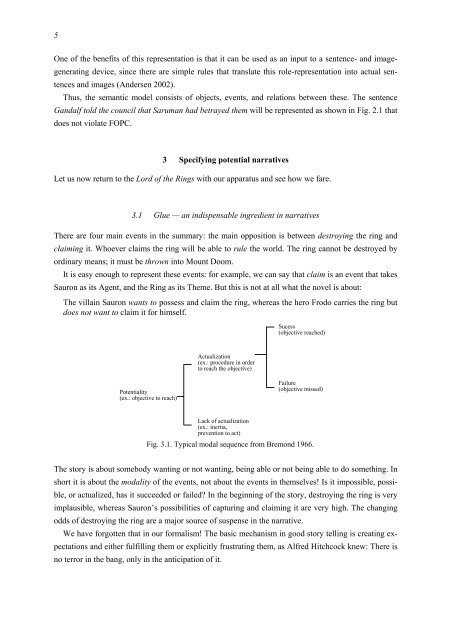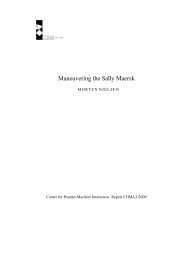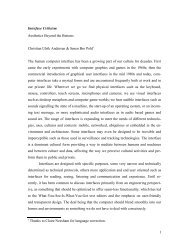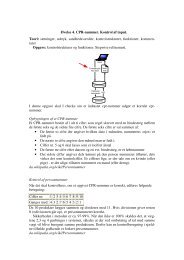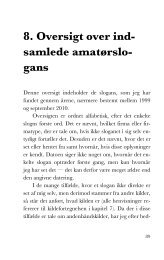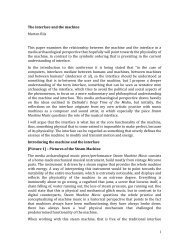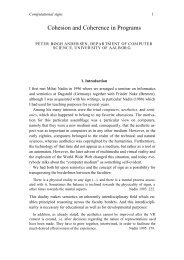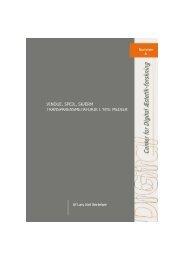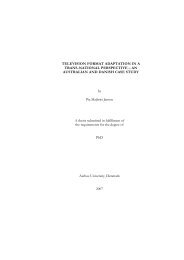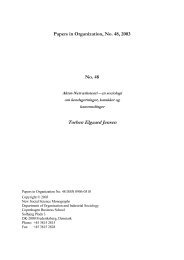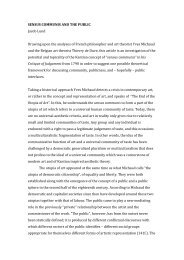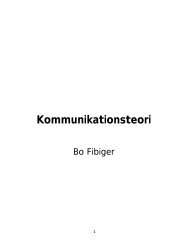Interaction and narration. Tearing Tolkien apart - CiteSeerX
Interaction and narration. Tearing Tolkien apart - CiteSeerX
Interaction and narration. Tearing Tolkien apart - CiteSeerX
You also want an ePaper? Increase the reach of your titles
YUMPU automatically turns print PDFs into web optimized ePapers that Google loves.
5<br />
One of the benefits of this representation is that it can be used as an input to a sentence- <strong>and</strong> imagegenerating<br />
device, since there are simple rules that translate this role-representation into actual sentences<br />
<strong>and</strong> images (Andersen 2002).<br />
Thus, the semantic model consists of objects, events, <strong>and</strong> relations between these. The sentence<br />
G<strong>and</strong>alf told the council that Saruman had betrayed them will be represented as shown in Fig. 2.1 that<br />
does not violate FOPC.<br />
3 Specifying potential narratives<br />
Let us now return to the Lord of the Rings with our apparatus <strong>and</strong> see how we fare.<br />
3.1 Glue — an indispensable ingredient in narratives<br />
There are four main events in the summary: the main opposition is between destroying the ring <strong>and</strong><br />
claiming it. Whoever claims the ring will be able to rule the world. The ring cannot be destroyed by<br />
ordinary means; it must be thrown into Mount Doom.<br />
It is easy enough to represent these events: for example, we can say that claim is an event that takes<br />
Sauron as its Agent, <strong>and</strong> the Ring as its Theme. But this is not at all what the novel is about:<br />
The villain Sauron wants to possess <strong>and</strong> claim the ring, whereas the hero Frodo carries the ring but<br />
does not want to claim it for himself.<br />
Sucess<br />
(objective reached)<br />
Actualization<br />
(ex.: procedure in order<br />
to reach the objective)<br />
Potentiality<br />
(ex.: objective to reach)<br />
Failure<br />
(objective missed)<br />
Lack of actualization<br />
(ex.: inertia,<br />
prevention to act)<br />
Fig. 3.1. Typical modal sequence from Bremond 1966.<br />
The story is about somebody wanting or not wanting, being able or not being able to do something. In<br />
short it is about the modality of the events, not about the events in themselves! Is it impossible, possible,<br />
or actualized, has it succeeded or failed? In the beginning of the story, destroying the ring is very<br />
implausible, whereas Sauron’s possibilities of capturing <strong>and</strong> claiming it are very high. The changing<br />
odds of destroying the ring are a major source of suspense in the narrative.<br />
We have forgotten that in our formalism! The basic mechanism in good story telling is creating expectations<br />
<strong>and</strong> either fulfilling them or explicitly frustrating them, as Alfred Hitchcock knew: There is<br />
no terror in the bang, only in the anticipation of it.


